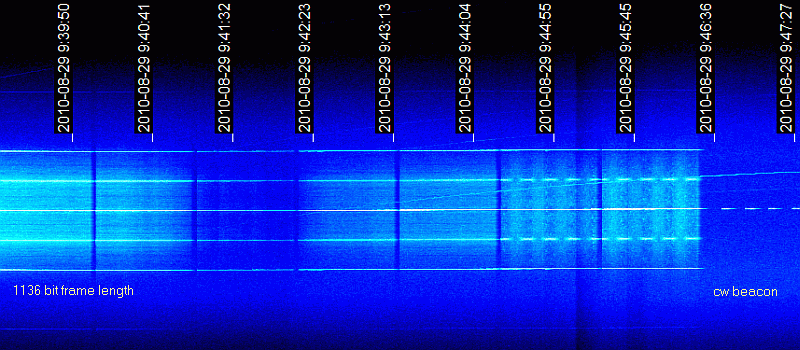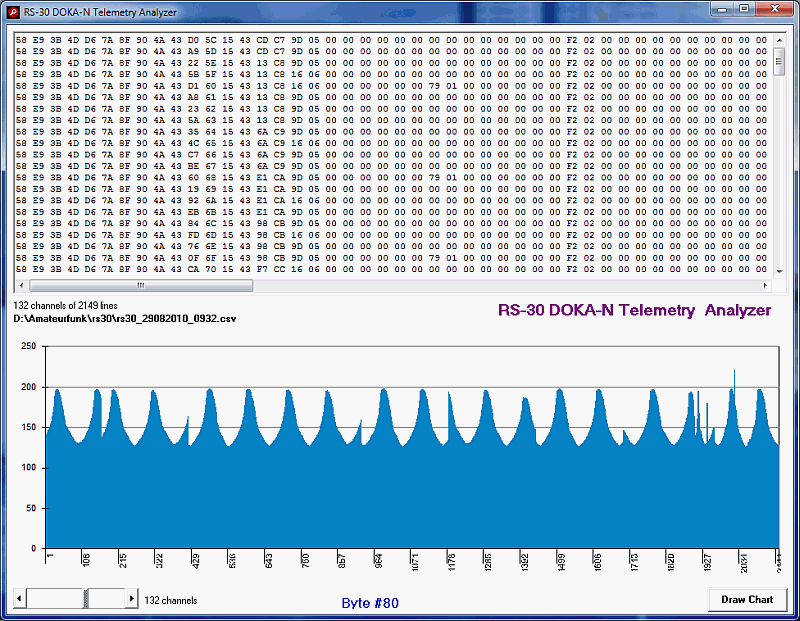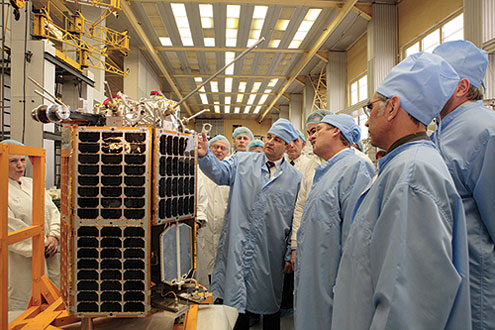
Am 23.05.2008 um 1520UTC startete vom nordrussischen Kosmodrom Plesetsk, Site 133 eine Rakete vom Typ Rokot ins All. In einer Höhe von etwa 1450km wurde die Payload – 3 militärische GONET D1M Satelliten (Kosmos-2437, 2438 and 2439) und ein Amateurfunksatellit ausgesetzt. Yubileiny (Radio Sputnik RS-30) wurde von der russischen NPO PM anlässlich des 50 Jahrestags des Sputnik 1 gebaut. Er hat ein Gewicht vonetwa 45kg. Entwickelt wurde der Satellit von der JSC “Academician M.F. Reshetnev” Information Satellite Systems” in Kooperation mit dem Aerospace Vehicle Laboratory (Russland, Kaluga), RPE “Geofizika – Cosmos” (Moskau), dem JSC “Saturn” (Krasnodar), Lavochkin NPO (Moscow), der Ramensk Instrument Building Company (Ramensk), Khrunichev State Cosmic Research and Production Center (Moscow) und der sibirischen Aerospace University (Krasnoyarsk).
NASA Catalog: 32953
Downlink
435.315 und 435.215 MHz CW und FM (Data)
 RS-30 CW Telemetrie (Pausen verkürzt)
RS-30 CW Telemetrie (Pausen verkürzt) RS-30 Datenübertragung
RS-30 Datenübertragung RS-30 Datenübertragung
RS-30 Datenübertragung
Status
aktiv
 RS-30 CW russische Nationalhymne
RS-30 CW russische Nationalhymne RS-30 CW Sputnik-1 Audiosignal
RS-30 CW Sputnik-1 Audiosignal
06.10.2008 – RS-30 sendet die russische Nantionalhymne und Audiosignale von Sputnik-1
27.05.2008 – 1730 UTC Vergleich mit TLE OBJECT A und TLE OBJECT C bis zum TCA -> RS-30 ist NORAD 32953 (OBJECT A)!
26.05.2008 – 1820 UTC mit TLE OBJECT A von AOS an ohne ein einziges mal nachzuregeln – konstante CW Frequenz von etwa 800 Hz bis zum Einsetzen der FM Datenübertragung (etwa 10 min).


25.05.2008 – Nach Angaben von NPO PM hat der DOKA-B Bordcomputer kurz nach der Abtrennung die Fluglagebestimmung und Lageregelung mittels der Magnetorquer (Magnetspulen die durch den Bordcomputer geschaltet werden) übernommen. Nach weniger als 4 Tagen soll damit bereits eine stabile Fluglage (magnetic orientation mode) erreicht werden. Sobald dies der Fall ist, wird die Bodenstation den Bordcomputer anweisen die Magnetorquer auszuschalten und den langen Boom für die Gravitationsstabilisierung ausfahren. Danach befindet sich der Satellit in einer 3-Achsen Stabilisation (3-axes gravity orientation mode). Es wird dann noch einmal etwa 1 Tag dauern, bis alle ungewünschten Schwingungen abgedämpft sind und der Satellit eine stabile Fluglage hat. Danach sollen dann die Tonkonserven von Sputnik-1 und auch Bilder in SSTV gesendet werden, nebst Telemetrie in FSK.
Peter, DB2OS
Orbital Parameter
Name RS-30 NORAD 32953 COSPAR Bezeichnung 2008-025-A Inklination (Grad) 82.500 RAAN 137.365 Excentrizität 0.0017467 ARGP 306.516 Umläufe pro Tag 12.42997542 Periode 1h 55m 50s (115.83 Min) Semi-major axis 7872 km Perigäum x Apogäum 1480 x 1508 km Mean Anomaly 11.300
CW Telemetrie
Name Possible limits Decoding parameters Assignment of parameters --------------------------------------------------------------------------------------- RS 30 Callsign UBS U=N * 0.087 Volts On board voltage N=115...175 IBS I=N * 0.02 Amperes On board current N=10...155 USUN U=N * 0.12 Volts Charge voltage from sun battery N=0...150 ISUN I=N * 0.01 Amperes Charge current from sun battery N=0...250 ITXA I=N * 0.01 Amperes DC Current of the 435 MHz Tx A N=0...200 ITXB I=N * 0.01 Amperes DC Current of the 435 MHz Tx B N=0...200 TTXA T=No decoding Temperature of the 435 MHz Tx A N=0...255 TTXB T=No decoding Temperature of the 435 MHz Tx B N=0...255 TNAP T=No decoding Temperature of the navigation unit N=0...255 TAB T=No decoding Temperature on board battery N=0...255 MSEP Table of operational modes of the power supply N=0...255 MCON Table of operational modes of the controller N=0...255 SMA Table of operational modes of channel A N=0...255 SMB Table of operational modes of channel B N=0...255 MRXA Table of operational modes of Rx A N=0...255 MRXB Table of operational modes of Rx B N=0...255 RS 30 Callsign.
rs30 us160 ibs12 usun0 isun0 itxa8 itxb1 ttxa65 ttxb66 tnap80 tab66 msep0 mcon53 sma83 smb63 mrxa2 mrxb2 rs30 us159 isb12 usun1 isun0 itxa8 itxb0 ttxa65 ttxb66 tnap80 tab66 msep0 mcon53 sma86 smb71 mrxa2 mrxb2
Telemetrie vom 25.05.2008, 21:16 UTC
DOKA-N System Datenübertragung
Modulationsart: Phasenmodulation, Manchester-Kodierung – 4800 bit/s, 1136 byte frame length
One burst contains 256 frames with sync and frame counter. Frame length differs from satellite to satellite, however sync word is always the same. Data contains interleaved data, it’s first and second part of a longer frame send on even and odd numbered frames.


a frame consist of 142 bytes (e.g. byte #80 analyzed)

weitere Infos
further information (original source)
The original Reshetnev press release for Yubileiny-1
Satellite mission and structure
The satellite «Yubileiny» is dedicated to educational, scientific research and experimental missions. First, the satellite launch will help to fulfill the Information Program foreseeing solutions of the major tasks of space exploration (voice messages, SSTV slides, signal imitation of the first artificial earth satellite); secondly it will help to establish conditions under which the Russian universities could study the data transmitted by the small satellite; and thirdly, it’ll help to carry out science-and-technologic experiments: Prospective Sun and earth sensors flight proficiency; Receiving data related to the Earth’s planetary emission within infrared wavelength band; Researches of spatiotemporal emissions of the Earth atmosphere day and night radiation within visible spectral range; Testing the estimation methods of the satellite attitude control concerning the data provided by the experimental solar sensors and small magnetometer MA-6; Proving efficiency of the nano-coatings developed by the SSAU to protect the spacecraft electronic components against radiation; Providing flight qualification for a prospective multifunction unpressurized platform intended for the 30-100 kg satellites; Testing the piggy-back injection (3 in a cluster) technology using the «Rokot» launcher. Structurally the satellite represents an unpressurized instrument module formed by a hexagonal frame with attached solar arrays and three lateral webs: top, bottom and central ones. The onboard equipment is installed inside the instrument module as well on the outer surface of the top panels. The top panel of the satellite that faces the Earth during the satellite operation is equipped with attitude control system devices, in particular, magnetometer and diagonal balancer booms, receiving and transmitting antennas and research equipment including three Earth sensors to receive data on the Earth’s planetary emission within infrared wavelength and spatiotemporal researches of the Earth atmosphere day and night radiation within visible spectral range. The spacecraft central panel carries the DOKA-B equipment comprising the onboard computer; receiving equipment operating in 145 MHz band; transmitting equipment operating in 435 MHz band as well as the onboard radio navigation equipment. The spacecraft bottom panel is equipped with magnetic and gravity attitude control system ensuring the satellite X-axis orientation towards the Earth in a nominal operation mode, navigation equipment antenna, experimental Sun sensors and the RADEK equipment, which is to prove efficiency of the nano-coatings developed by the SSAU to protect the spacecraft electronic components against the radiation impacts. Solar arrays panels installed on the satellite’s frame are made of the three-junction gallium arsenide cells. The solar arrays will supply power to the onboard equipment when in the illuminated orbits. The frame design allows the required size of the solar array effective area with the satellite being in different positions relative to the Sun. During the orbital eclipse periods the equipment is powered with the nickel metal hydride battery. The EPS battery is not an individual element. Its components are incorporated into the command and power unit where all power supply automatics is installed, these are the DOKA-B equipment components. The peculiarity of the «Yubileiny» lies in its passive thermal control subsystem: the necessary temperature is provided by the uncontrolled ratio of optical coefficients characteristic for the surfaces of spacecraft structural elements, MLI, electric heaters and heat pipes that ensure the thermal mode for the DOKA-B equipment. The DOKA-B software ensures electric heaters control which is as follows: if the temperature sensors indicate temperature fall till 0°C then the electric heaters are switched on, if the temperature rises up to 5°C, the electric heaters are switched off. The flight software estimates an average temperature according to data of the three temperature sensors. The electric heaters are controlled considering the average temperature.
Spacecraft nominal operation mode
The satellite «Yubileiny» is injected in a cluster with satellites developed for the Russian Ministry of Defense. In 30 seconds after the satellite separation from the ascent unit the initial preparation mode is switched on. Above all, the DOKA-B powers the pyro cartridge to deploy the145.8 MHz antennas, makes the receivers ready to get the ground control commands, and supplies power to the magnetometer coil. Then the attitude determination and control system undergoes damping and magnetic orientation. In total, it takes no more than 4 days to accomplish all operations. After conformation of the stable magnetic orientation mode within the radio visibility range the Satellite Control Center sends the commands «current coil off», «HDM release» and «moving out» the diagonal booms. The gravity boom is passively moved out, the diagonal booms are deployed and the spacecraft comes into 3-axes gravity orientation mode. It takes 1 day to damp the satellite till it reaches the stable gravity orientation after moving out the gravity boom. After checking the satellite systems, the data related to the first artificial satellite launch is downloaded. The transmission lasts for 4 minutes. Within this time the following data is downloaded: a call signal and TM-data (10 seconds); a voice message (1 minute); a pause (50 seconds the first artificial satellite imitated signals (10 seconds); an image (1 minute); a pause again (50 seconds). The onboard spacecraft data is transmitted via a radio channel in the 435 MHz international frequency band of experimental and radioamateur communications, in cyclic mode, in narrow-band FSK mode. Voice messages and images can be received in any place of the Earth when the satellite floats above within the radio visibility ranges. Any standard radio equipment can receive the signal in this frequency band requiring no additional technical means.
The onboard navigation equipment is switched on once a day for 10 minutes to determine, without the ground support, the parameters of the spacecraft motion along the near earth orbit. The onboard equipment meant for the satellite-based navigation can use the signals of GLONASS and NAVSTAR (GPS) systems in any combination.